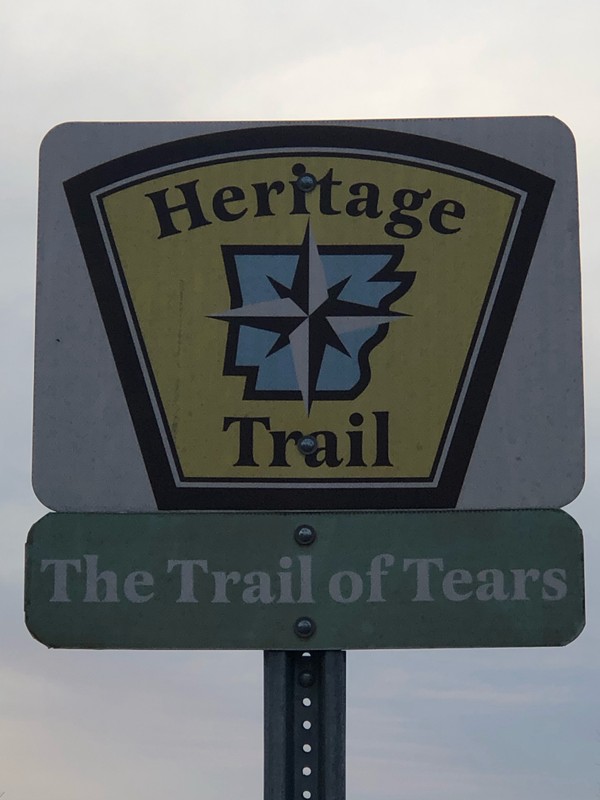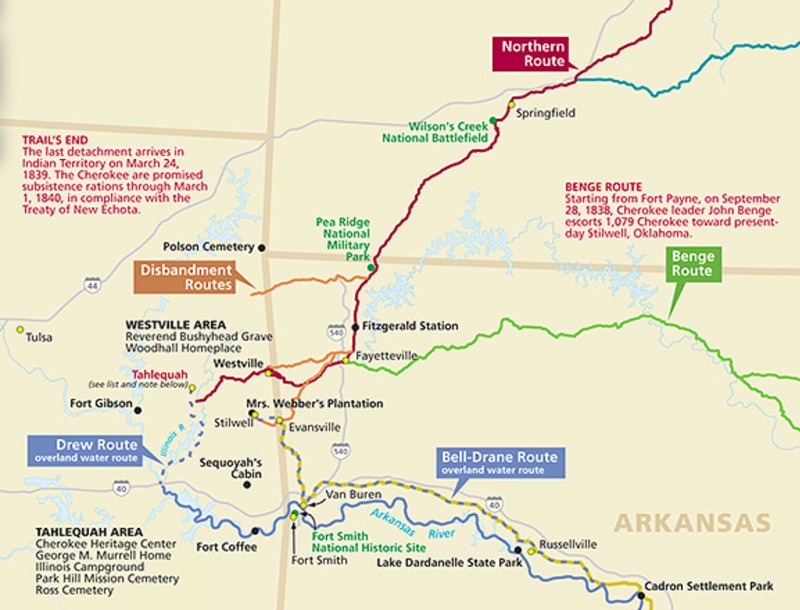The Trail of Tears Historical Marker- Bentonville
Introduction
Text-to-speech Audio
This historical marker is located near the city's Museum of Native American History and serves as a reminder that Bentonville was one of many communities in northern Arkansas near the various paths Native Americans were forced to travel between 1830 and 1840. Together, these paths are known as the Trail of Tears. These trails originate in present-day Georgia and pass through Arkansas before concluding in present-day Oklahoma. Many Native tribes traveled these paths, which all crossed through Arkansas, although the plight of the Cherokee Nation is the best known. Many members of the Cherokee crossed through the area now home to Bentonville. They also passed through Springdale, Arkansas, which is home to a monument. In 1987, the land route of the Trail of Tears National Historic Trail, previously called the Northern Route of the Cherokee, was documented and recognized by the United States Congress. Like most of the markers on that trail, this sign does not offer interpretation, which is where a digital marker like this might be useful.
Images
The Trail of Tears historical marker located in Bentonville, Arkansas

Map of the Trail of Tears highlighting the Northern Route through Arkansas into Oklahoma

Backstory and Context
Text-to-speech Audio
The Trail of Tears is a series of paths traveled by Native American tribes during the forced relocation that followed the Indian Removal Act of 1830. This loose collection of paths and rivers connect Native homelands, through Kentucky, Tennessee, Missouri, and Arkansas before concluding in "Indian Territory," today known as Oklahoma. The tribes were forced from their lands and made to travel across the United States to the “Indian Colonization Zone”, or Indian Territory as it was commonly referred to as. The purpose of the Indian Removal Act, which was proposed by Congress and signed into effect by Andrew Jackson, was to remove Indians from Georgia and other Southern states so that white settlers could take possession of these valuable lands.
Previous treaties had treated the so-called “Five Civilized Tribes” differently from others with less power and influence, leading members of these tribes to accept treaties and believe that they would be permitted to stay in the South. The differential treatment helped colonization by creating divisions between tribes and preventing pan-Indian unity. However, these "civilized tribes" decision to accept many of the economic and cultural aspects of European civilization did not allow them to be accepted as equals, and once their lands became commercially valued, they shared a similar fate of other tribes. Starting in the 1830s, these five tribes (Cherokee, Choctaw, Chickasaw, Seminole, and Creek) were forced from their lands.
The President of The United States during this time was Andrew Jackson, a man who rose to celebrity status following the Battle of New Orleans. Andrew Jackson later solidified his support among many white Americans by attacking Native peoples in Florida which led to the acquisition of that territory in the years that followed. As president, Jackson made the removal of Native Americans a leading priority. The Indian Removal Act of 1830 authorized the United States government to negotiate treaties with Native tribes that signed over their lands in exchange for lands west of the Mississippi River. These lands were previously acquired through the lands of the Louisiana Purchase, and few if any provisions were made for the tribes that already lived in these areas.
The Executive branch of the United States government under the direct orders of Andrew Jackson then authorized the use of military force against Native American tribes who were increasingly coerced into signing a series of treaties. This action was followed by the physical removal via rivers and forced marches, a process that lasted about a decade and resulted in many deaths. The Cherokee Nation tried to fight their removal in court. They also hoped Congress would overturn the 1835 treaty by offering evidence that the Native leaders who signed that treaty were not authorized to speak for all Cherokee. These efforts failed, and Cherokee tribal leaders responded by asking for resources to support the removal of their people in hopes of preserving lives.
Some Natives traveled west by walking barefoot, others traveled by wagon and steamboat either in small groups or large caravans. The weather during this time was recorded to be some of Arkansas’ coldest winters and driest summers. Many removal groups had physicians assigned to them but many still died from diseases such as smallpox, cholera, measles, and dysentery. Without exact records, the best historians can offer are estimates of the number who are buried along the Trail of Tears. Between 60,000-100,000 Indians were forced to make the trip, and it is believed that between 10,000-15,000 Natives perished on the journey or closely after arrival in present-day Oklahoma. This movement along various paths was later referred to as the Trail of Tears because of the harsh conditions, lives lost, and emotional turmoil the Native Americans faced. The name, Trail of Tears, refers to the collective removal at this time but is most often associated with the removal of the Cherokee Nations from October 1838 to March 1839. In the Cherokee language, the movement is known as unuahi-duna-dlo-hilu-i-- “the trail where they cried.”
Cite This Entry
Chelsea Whitehouse and Clio Admin. "The Trail of Tears Historical Marker- Bentonville." Clio: Your Guide to History. July 17, 2021. Accessed February 13, 2025. https://theclio.com/entry/120295
Sources
Sloan, Kitty. Trail of Tears, Central Arkansas Library System: Encyclopedia of Arkansas. December 19th 2020. Accessed November 23rd 2020. https://encyclopediaofarkansas.net/entries/trail-of-tears-2294/ .
Spurgeon, John. Trail of Tears National Historic Trail, Central Arkansas Library System: Encyclopedia of Arkansas. April 4th 2018. Accessed November 23rd 2020. https://encyclopediaofarkansas.net/entries/trail-of-tears-national-historic-trail-4887/ .
The Five Civilized Tribes, The American History. 2020. Accessed November 23rd 2020. http://theamericanhistory.org/five-civilized-tribes.html .
Freidal, Frank & Sidey, Hugh. The Presidents of the United States of America, Whitehouse Historical Association. January 1st 2006. Accessed November 23rd 2020. whitehouse.gov/about-the-white-house/presidents/andrew-jackson/ .
Cannon, B. B.. Journal of B.B. Cannon-- Cherokee Removal, 1837, University of Arkansas at Little Rock: Trail of Tears Through Arkansas Eye Witness Accounts. (1837). Accessed November 23rd 2020. https://ualrexhibits.org/trailoftears/eyewitness-accounts/journal-of-bb-cannon-cherokee-removal-1837/.
Whitehouse, C. (2020). The Trail of Tears Historical Marker
Trail of Tears National Historic Trail Map. (2020). National Park Service: Trail of Tears. https://www.nps.gov/trte/planyourvisit/maps.htm

